
Starting a ride-hailing or shared mobility venture can seem overwhelming, but with a clear plan, it's possible to launch in just 90 days. This guide outlines a three-phase process: laying the foundation, building your product and team, and launching - plus tips for growth beyond day 90. By following this roadmap, you’ll validate your idea, ensure legal compliance, create your brand and technology, recruit drivers, and hit the market ready.
Day 0–30: Foundation
Finding a niche
Start with market validation and legal setup. Research your target area to identify unmet transport needs. Maybe large providers don’t serve certain areas, or there’s demand for eco-friendly, or premium segment or niche services like women-only rides.
Looking to stand out in the competitive ride-hail market? Check out these two insightful reads:
- Finding a niche in the competitive ride-hail market: https://www.atommobility.com/blog/how-to-find-your-niche-in-the-competitive-ride-hail-market-real-world-examples-of-businesses-that-resonate
- Discover how a local taxi union in Sweden supports a new platform to reshape industry standards and build a fairer ecosystem: https://www.atommobility.com/blog/driving-change-with-fair-how-a-small-platform-is-redefining-the-taxi-industry-in-sweden
This should help you define your niche, unique positioning or angle, and ultimately your unique selling proposition to stand out from other players in the market.
Legal compliance
Next step will be forming your business (e.g., LLC) to protect liability and later attract investors. Apply for the necessary permits, such as TNC licenses, and consult local regulations. Insurance is essential – you’ll need commercial liability coverage that also includes drivers. Run background checks to ensure safety and compliance.
Legal compliance checklist:
- Business registration
- Ride-hailing or taxi permits
- Driver background checks
- Commercial insurance
- Local regulation compliance (e.g., vehicle checks)
Budgeting for MVP launch
Outline core costs: software, licenses, insurance, marketing, driver incentives, customer support, accounting services, and some reserve. Use a white-label software like ATOM Mobility to avoid costly custom builds. These platforms offer rider/driver apps and backend systems for a fraction of development costs.
Plan an initial marketing budget (e.g., €1,000–€5,000) and allocate driver sign-up bonuses (€100 for 20 rides, for example). Include small expenses like Apple developer accounts or a place in co-working to work from. Keep costs lean and prepare a detailed budget for the first 6-12 months.
Financing: Bootstrapping vs. investors
Once you have a 6-12 month budget prepared, you can choose between personal funding, angel investors, or crowdfunding. Bootstrapping (using your personal capital) offers control but limits scale. Local group of angel investors can contribute €50k–€500k in total and extra mentorship. Crowdfunding helps raise funds while building a local supporter base. For example, you can engage drivers to invest via crowdfunding in exchange for a small equity share in your company and free usage of the platform for a certain period.
Here’s a helpful resource on using crowdfunding to kickstart your venture and get inspired: https://www.atommobility.com/blog/crowdfunding-for-your-vehicle-sharing-business
If your budget analysis shows you need external funding, try at least to launch a small-scale, working prototype with personal funds or an FFF (friends, family, and fools funding) round before entering the investment process. Demonstrating even modest traction significantly boosts your chances of a successful raise.
Please note that securing your first round of funding - whether from crowdfunding or business angels - typically takes six or more months. To keep momentum going, launch an initial version of your product or service, then start the fundraising process.

Day 30–60: Build & integrate
Software
Choosing the right software partner can make or break your new ride-hail venture. From cost efficiency and faster time-to-market to reliability and specialized industry knowledge, the benefits of a white-label solution often outweigh the complexities and expense of building from scratch. Be sure to evaluate each provider’s platform features - rider and driver apps, dispatch system, and payment tools—alongside their proven track record of scaling and entering different markets. Confirm their customization capabilities, pricing transparency, and ability to expand into new service zones as your business grows. Ultimately, opt for a partner that delivers both the technology and the strategic support you need. For more insights on this decision-making process, explore white-label solutions vs. building from scratch and discover Why ATOM for a deeper dive into selecting the right tech partner.
Create a clear branding identity
Start by selecting a memorable name that reflects both your niche and city - AI-powered tools like ChatGPT can speed up brainstorming. Next, design a simple logo and choose core colors using user-friendly platforms such as Canva or Looka. Consistency is key, so use these design elements across your website and social channels.
When it’s time to launch your online presence, opt for no-code platforms like Squarespace, or Carrd to create a minimal landing page in minutes -no developers needed. Clearly present your core message (e.g., “Premium, all-black Mercedes rides in [City].”), include links to your rider/driver apps, and offer driver sign-up form. This straightforward approach helps potential users and drivers quickly understand and trust your brand.
Driver onboarding (first 50 drivers)
Your service can’t run without drivers, so make their onboarding experience as smooth and appealing as possible. Start by defining tangible benefits - like 0% commissions for the first three months, niche perks, or local partnerships—that set you apart. Reach out via social media, online communities, and direct messaging to recruit your initial loyal driver base. Host webinars or info sessions to keep them engaged and address any concerns.
Keep in mind, your first drivers are crucial for user satisfaction: they are the face of your service and heavily influence each ride’s quality. Consider providing branded merchandise and clear guidelines—such as offering free candies or bottled water, opening doors, or any other gesture aligned with your unique selling proposition (USP).
To streamline onboarding, create a simple website form for sign-ups, ensure fast document verification, run background checks, and offer concise training modules. Incentives like sign-up bonuses or a zero-commission period can help you recruit your first group of drivers quickly. You might also guarantee initial earnings (covering fixed fees from your budget) to build driver trust while you grow your user base.
Goal: By day 60, aim to have at least 50 drivers signed up and ready to serve your launch zone, setting a solid foundation for your platform’s success.
Day 60–90: Test & launch
Closed beta testing
Before a full launch, invite a small group of friends, family, or early supporters to test your app and simulate real-world scenarios. Focus on the essentials: ride requests, payment processing, GPS accuracy, and cancellation flows -ideally at various times of day and on different devices. Take a few actual rides with real drivers to see how they follow outlined procedures and interact with riders. Gather feedback to uncover any usability issues or unexpected driver behaviors.
During this phase, refine your internal processes as well. Decide how you’ll handle customer inquiries - whether via a dedicated help email, chat support, or both - and respond promptly to build trust. If you have a team, ensure everyone is on the same page about responsibilities, communication guidelines, and how to address rider or driver concerns. This targeted approach helps you iron out potential issues, polish the user experience, and establish robust support protocols before going public.
Public launch
Decide whether to roll out quietly (a soft launch) to iron out any last-minute bugs or make a big announcement with a press release. If you choose the latter, pitch your story to local media outlets, emphasizing your community-first approach to mobility. Launch promotions - like 50% off first rides or a €5 sign-up credit - are a great way to attract early adopters and generate buzz.
Make sure your driver pool is ready to handle demand by coordinating schedules and availability. Consider offline tactics, too: distributing flyers in high-traffic areas, setting up campus booths, or sponsoring community events can help you gain local exposure. Once you’re live, keep a close eye on rider feedback (e.g., ride ratings, app store reviews) and address issues swiftly to maintain a positive user experience.
Marketing & growth to 1,000 rides
Partner with local influencers to promote your app, offering free rides or small payments in exchange for authentic social media posts. Focus on influencers your target audience trusts. Implement app referral programs - reward users and their friends with ride credits to spark word-of-mouth growth.
Keep engagement high by sharing milestones and user success stories online. Show up at local events, offering exclusive promo codes to attract new riders. Begin with small-scale digital advertising, reinvesting as you generate revenue and learn which channels work best. Track core metrics like sign-ups, ride volume, and wait times so you can make data-driven decisions and refine your strategy in real time.
Post 90 days: Scaling
Customer support & operations
As your platform grows, consider outsourcing or automating aspects of customer support. Create a help center or FAQ to guide users to quick solutions, and keep daily operations under close watch so you can resolve any issues swiftly. To remain efficient, hire part-time help (e.g., marketers or fleet managers) who can handle specialized tasks without inflating your overhead.
Fundraising
With initial traction in place, you’re in a strong position to secure additional funding. Present clear data on ride volume, user retention, and revenue growth to potential angel investors or crowdfunding platforms. Government grants may also be available for sustainable transport initiatives, so explore those opportunities. Be specific about how the funds will be used - for instance, "We need €100 000 to expand into two new cities and reach 10,000 rides per month."
The 90-day timeline
Although launching a ride-hail platform in 90 days is ambitious, a focused strategy and lean tooling can make it possible. Stay agile, keep service quality at the forefront, and set tangible milestones for each stage. With strong local insights and consistent execution, you can carve out a lasting presence in the mobility space.
Growth & expansion
Before moving into new cities, solidify your position in your initial market. Continue recruiting drivers and reaching fresh rider segments through targeted partnerships and loyalty programs. If you decide to scale further, use your 90-day playbook again—tweaking it for each new region’s unique challenges and opportunities. Good luck!
Click below to learn more or request a demo.
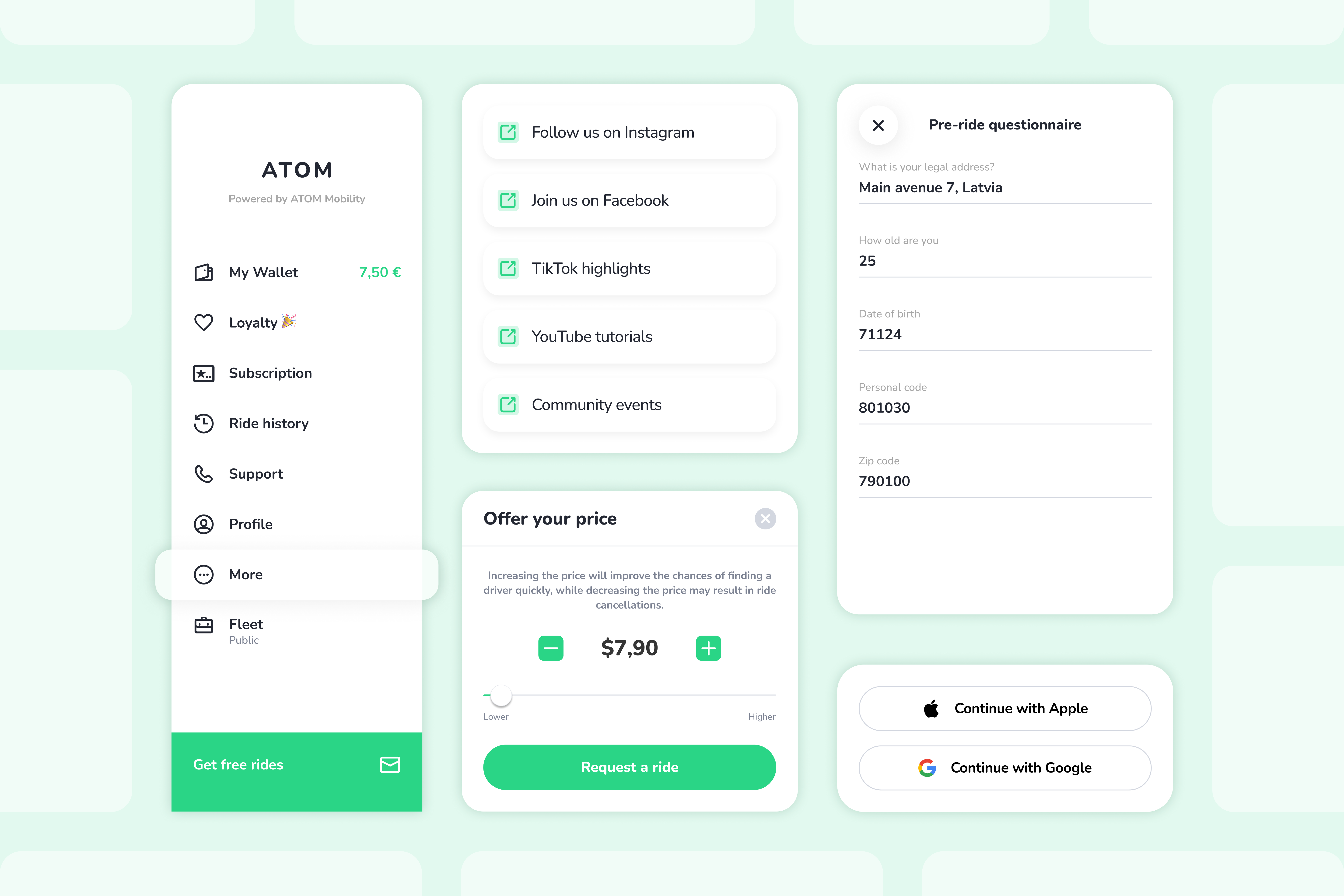
🚀📱2025 was all about automating more and reducing friction across mobility. ATOM Mobility introduced OpenAPI, new sign-in flows, a rental web-booker, smarter fleet automation, and a wide range of new hardware and payment integrations. A faster, more flexible, more scalable mobility platform - built for operators who want to grow.
2025 has been a defining year for shared mobility, digital rentals, and ride-hailing. Competition is stronger, operational costs are rising, and users expect instant, reliable digital experiences. Operators who succeed are the ones who automate more, reduce friction, and stay flexible with hardware, payments, and integrations.
This year, ATOM Mobility shipped a series of features designed to help operators achieve exactly that:
grow revenue, reduce costs, improve fleet quality, and scale into new markets with less complexity.
Here are the 10 most impactful (out of more than 70) features ATOM Mobility released in 2025, and why they matter.
1. OpenAPI (supported by all 3 modules - vehicle sharing, digital rental and ride-hail)

The launch of ATOM’s OpenAPI marks a major step forward for operators seeking greater flexibility, automation, and integration possibilities.
What it is
A fully documented API layer allowing operators and partners to build custom flows, integrations, booking systems, analytics dashboards, or MaaS connections on top of ATOM Mobility.
Who it helps
All verticals: micromobility, car-sharing, moped sharing, rentals, ride-hail, and enterprise partners.
How it works
OpenAPI enables third-party developers to build on top of the ATOM Mobility infrastructure, allowing seamless integrations with external apps, internal tools, and automated workflows. With OpenAPI, operators can extend their service in almost any direction: a partner app (like FreeNow or Uber) can show your vehicles, unlock them, and process payments on your behalf; or internal systems can trigger automated actions - such as sending a survey email after every completed ride. The possibilities are nearly unlimited, giving operators full flexibility to innovate and scale however they choose.
Why it matters
- Enables deeper integrations with partners and local platforms
- Supports custom business logic and automations
- Makes it easier to enter new markets with local-specific requirements
- Opens the door to MaaS distribution and enterprise collaborations
2. Sign-In with Apple & Google - A smoother first-time user experience (all modules)

Across mobility, the registration flow is often the first point of friction. ATOM Mobility introduced modern authentication options to simplify onboarding.
What it is
One-tap sign-in using Apple ID or Google Account instead of relying solely on SMS verification.
Who it helps
All operators - especially those targeting tourists, or markets with unreliable SMS delivery.
How it works
When creating a new account or logging in, users can choose to log in/register using Apple ID or Google Account - this will allow account creation in just 2 taps.
Why it matters
- Faster user onboarding experience -> happier rider -> more frequent rides
- Fewer SMS-related issues (and lower SMS related costs) and failed verifications
- Reduced support load from login problems
3. Multipurpose side menu button (all modules)

What it is
A customizable slot in the app menu where operators can add up to five external links - websites, ecommerce pages, tour pages, extra FAQ pages, social media, partner offers, etc.
How it works
- Enable in Settings → System preferences → External links
- Add titles + URLs
- Links automaticaly appear in the app under “More”
Value for operators
- A space where you can display any information you consider important for the user
- Supports cross-promotion and partnership campaigns
- Allows communication updates without app releases
- Creates additional monetisation opportunities, such as launching your own e-commerce or merchandise shop
4. Pre-ride questionnaire (all modules)
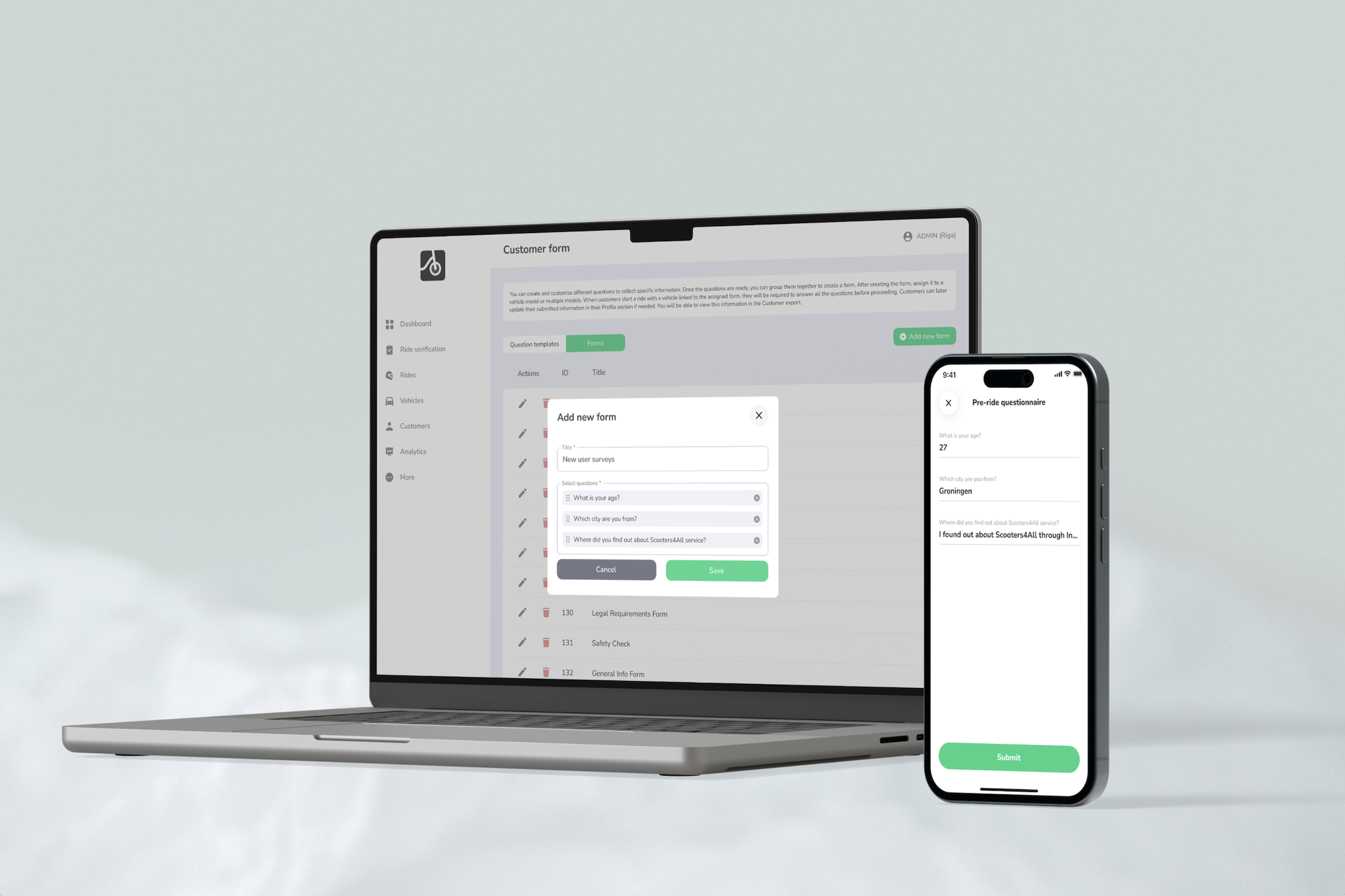
What it is
A form that users must complete before starting a ride - ideal for compliance, reporting, invoicing, or gathering important data.
Who it helps
Operators needing regulatory data, reporting, consent collection, or structured user feedback.
How it works
Create a question (or several) in “Customer form” -> Group questions into a pre-ride form -> Assign a form to specific vehicle models/classes.
Once completed, the customer must answer predefined questions before starting the ride. Their responses appear in both customer and ride exports. For example, you can ask for a personal ID code, legal address, or any other required information.
Value for operators
- Helps meet regulatory or municipal requirements
- Ensures correct invoicing details
- Provides a structured way to capture essential user data
5. Driver revenue auto-distribution (Stripe & Adyen, ride-hail)
What it is
Automatic payout splitting: driver earnings go to the driver’s payout account, and platform commission goes to the operator - all processed automatically after each ride.
Who it helps
Ride-hail operators using Stripe or Adyen.
How it works
- Operator has a Stripe/Adyen merchant account
- Drivers onboard as payout recipients
- After completed rides, payouts split automatically
- Supports mixed payment methods (cash and non-cash)
Value for operators
- Reduces manual payout work
- Minimises accounting errors
- Improves driver experience through transparency and instant pay out
- Makes scaling easier when the driver base grow
6. Set a manual vehicle location (vehicle sharing & digital rental)
What it is
A tool to override or manually set a vehicle’s GPS position when IoT data is unavailable (no IoT placed on the vehicle at all) or inaccurate.
Who it helps
Operators with underground parking, poor GPS coverage, or long-term rentals without IoT can use this setup. A typical scenario is long-term bike rental without IoT: the user completes ID verification, payment, and booking in the app, then sees the vehicle assigned to a predefined location (station) where it is picked up and later returned. This serves as a workaround for vehicles that do not support IoT or where adding IoT device is too costly.
How it works
Edit vehicle → update “Location” field. The system assumes this as the correct coordinate. Works for individual vehicles or via mass import.
Value for operators
- Avoids user frustration when vehicles appear in the wrong location
- Supports business modesl with fleets operating without IoT devices
7. Offer your price - rider-controlled pricing (ride-hailing)
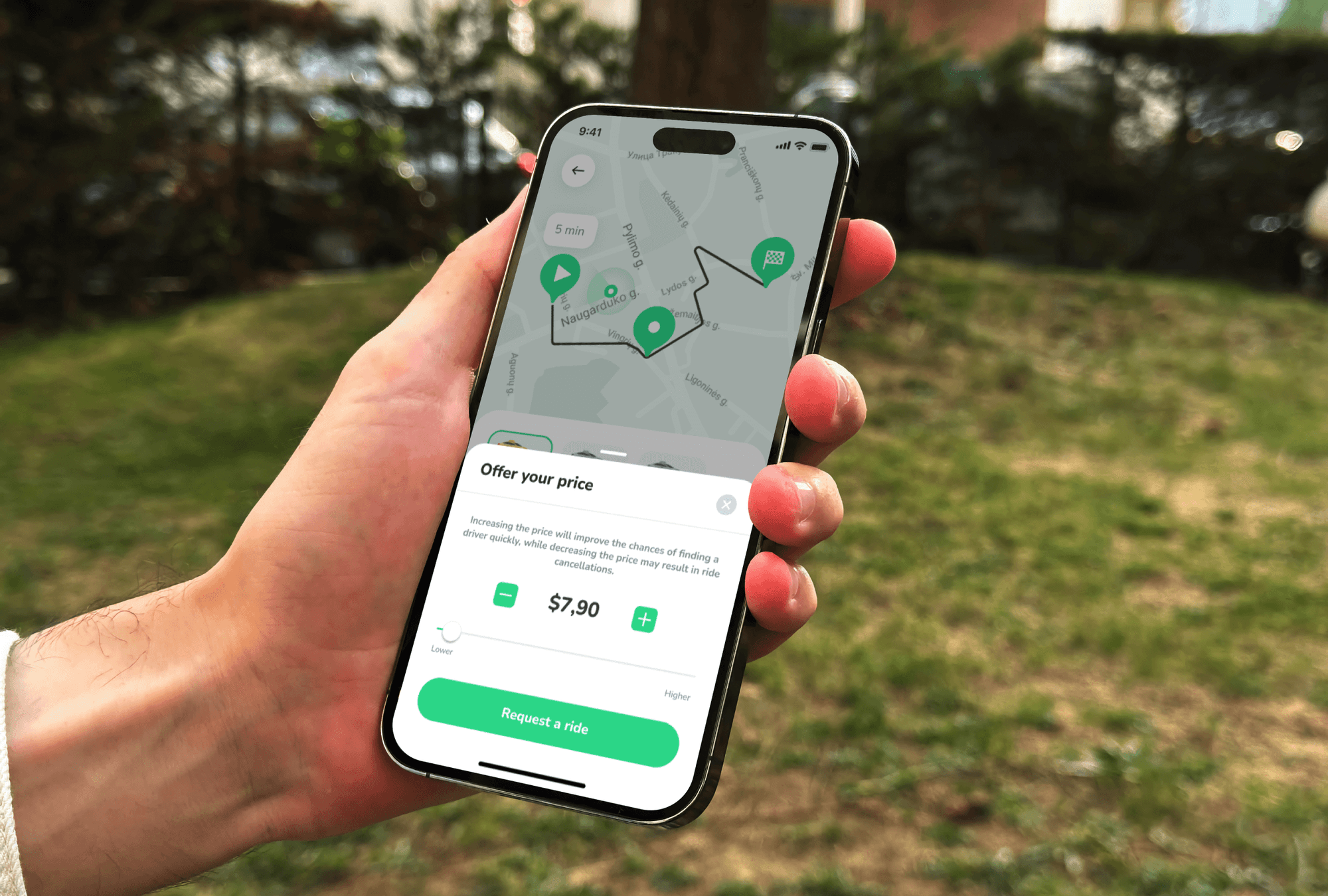
What it is
A flexible pricing feature that lets passengers propose their own fare - higher or lower than the system-calculated price, within limits set by the operator. Drivers see the offer instantly and can choose to accept or reject it.
Who it helps
Ride-hailing operators in competitive, price-sensitive, or highly dynamic markets where price shifts demand quickly.
How it works
When requesting a ride, the user selects “Offer your price”. A slider or +/– buttons allow them to adjust the fare within operator-defined boundaries. If the user lowers the price, the app explains that the offer may reduce the chance of driver acceptance.
Drivers see a clear banner showing whether the rider is offering more or less than the standard fare. Drivers can accept or decline based on their preference.
Operators can enable or disable the feature per vehicle class.
Why it matters
- Creates a clear differentiator in markets dominated by fixed-fare competitors
- Helps convert riders who compare multiple apps before booking
- Gives drivers more control over their earnings and decisions, improving transparency and satisfaction
- Supports better ride matching during off-peak hours or less profitable routes
- Allows operators to experiment with more flexible pricing strategies without changing their core fare model
8. Web-booker for digital rental - frictionless bookings directly from your website (digital rental)
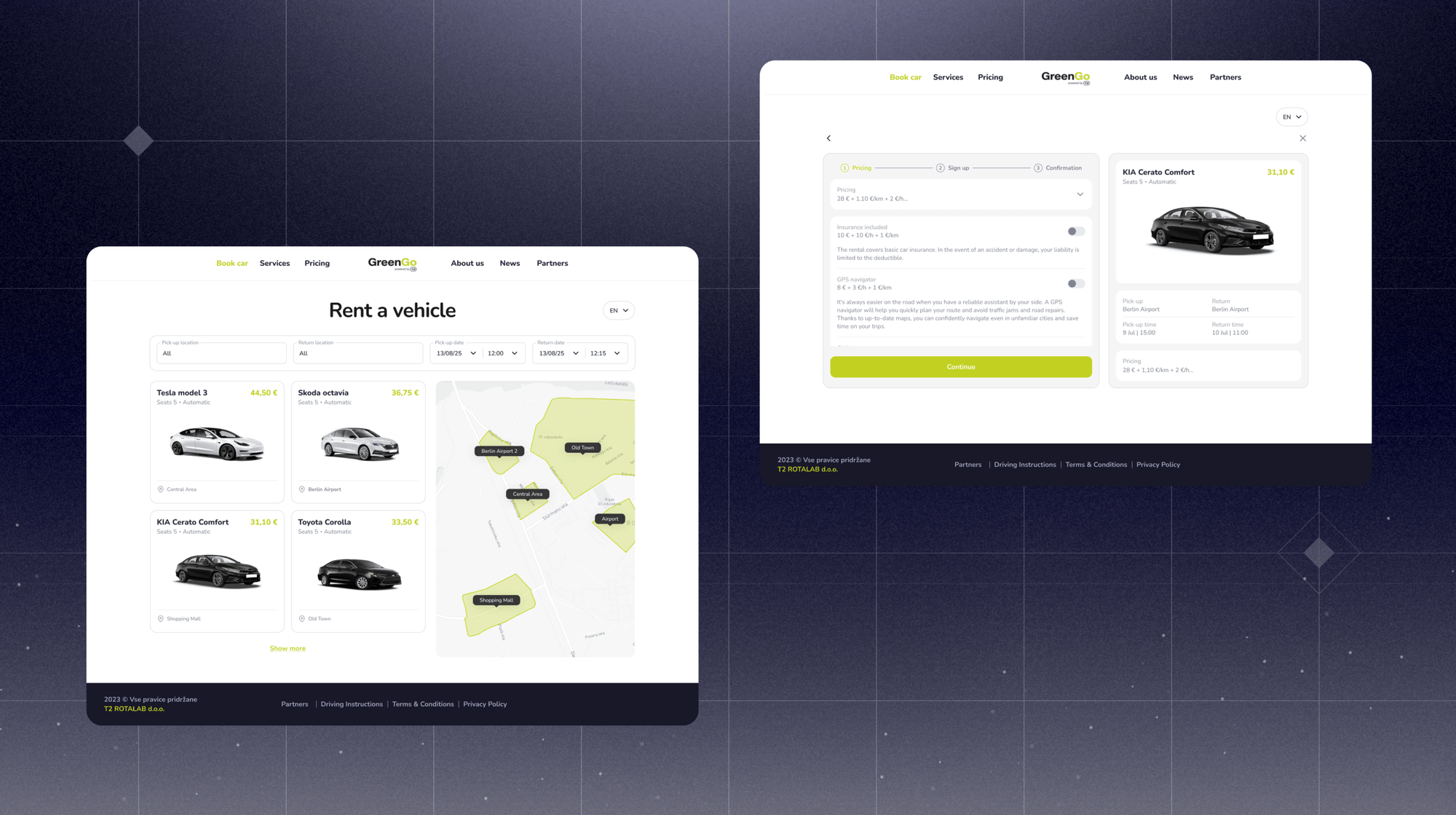
What it is
A lightweight, embeddable booking widget that lets customers reserve a rental vehicle directly from your website - without installing the mobile app first. It’s designed to capture spontaneous bookings, convert website visitors, and unify online and in-app rental experiences.
Who it helps
Car, moped, and bike rental operators, as well as hospitality and tourism partners such as hotels, resorts, coworking spaces, real-estate developers, and travel service providers.
How it works
Every operator receives a branded rental URL: merchantname.atommobility.com/rent
Users select their area, vehicle type, and rental period directly in the widget. Once confirmed and the account created, the booking syncs automatically into the ATOM Mobility dashboard. Customers see a confirmation screen with a QR code to open the booking in the mobile app. Payment, ID verification, and vehicle unlock actions are completed in the ATOM Mobility-powered app before the trip begins.
The widget automatically adapts to the operator’s brand color for a visually seamless integration. In the dashboard, each booking displays its source: App, Web, or Booker - helping operators track where rentals originate.
Why it matters
- Converts first-time users browsing your website into paying customers - without forcing an app install
- Enables plug-and-play rental flows for partners such as hotels, rental desks, cafés, coworking spaces, or tourist spots
- Supports QR-based rental journeys from physical locations
- Reduces friction for users who want a fast, simple booking experience
- Helps operators expand distribution with minimal effort, unlocking new sales channels
- Unifies online and mobile rental flows under a single backend and operational system
Demo: https://app.atommobility.com/rental-widget
9. Vehicle status change automation (vehicle sharing & digital rental)
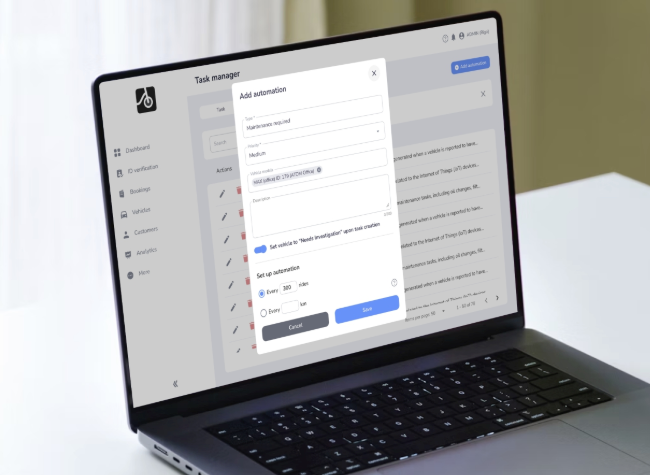
What it is
Bad user experiences often happen when several riders encounter the same faulty vehicle. ATOM Mobility now prevents this automatically. Automation rules detect problematic vehicles and instantly set them to “Needs investigation,” hiding them from the user app so the operator can inspect the vehicle before the next rider can take it.
Who it helps
Sharing and rental operators managing medium or large fleets.
How it works
System monitors low ratings, repeated short rides, and user reports. When triggered, it:
- creates a maintenance task
- switches vehicle status
- hides the vehicle from users
Why it matters
- Prevents recurring complaints from the same issue
- Reduces refunds and reputational damage
- Helps maintain a healthier, more reliable fleet
- Automates routine operational checks
10. New integrations (10) - a broader ecosystem for hardware, payments & compliance (all modules)
What was added
2025 brought a wave of new integrations that give operators more flexibility in choosing hardware, payments, charging, and regulatory tools. What was added:
- Ridemovi IoT
- Wave payment gateway
- Linka smart lock support
- 2Hire IoT
- Kuhmute charging stations
- Eskiz.uz OTP service
- Atmos payment gateway
- Chiron API (regulatory)
- Fitrider charging station
- Azericard payment gateway
Why it matters
- Easier entry into markets with local payment or OTP requirements
- More hardware options for scooters, bikes, e-bikes, and cars
- Better compatibility with charging infrastructure
- Reduced integration time when expanding
- Support for regulatory compliance where required
These ten features represent only a small selection of what we delivered this year. In total, our team shipped more than 70 new features, dozens of integrations, and countless small improvements that quietly make the platform faster, more stable, and more enjoyable for operators and end-users every single day. Behind each release is a team focused on one idea: helping entrepreneurs build stronger, more efficient, and more profitable mobility businesses.
And we’re just getting started.
Our 2026 tech pipeline is already packed with ambitious and exciting solutions - from deeper AI-powered automation to smarter fleet intelligence and new tools that will change how operators run mobility services. We're looking forward to pushing the industry even further together.
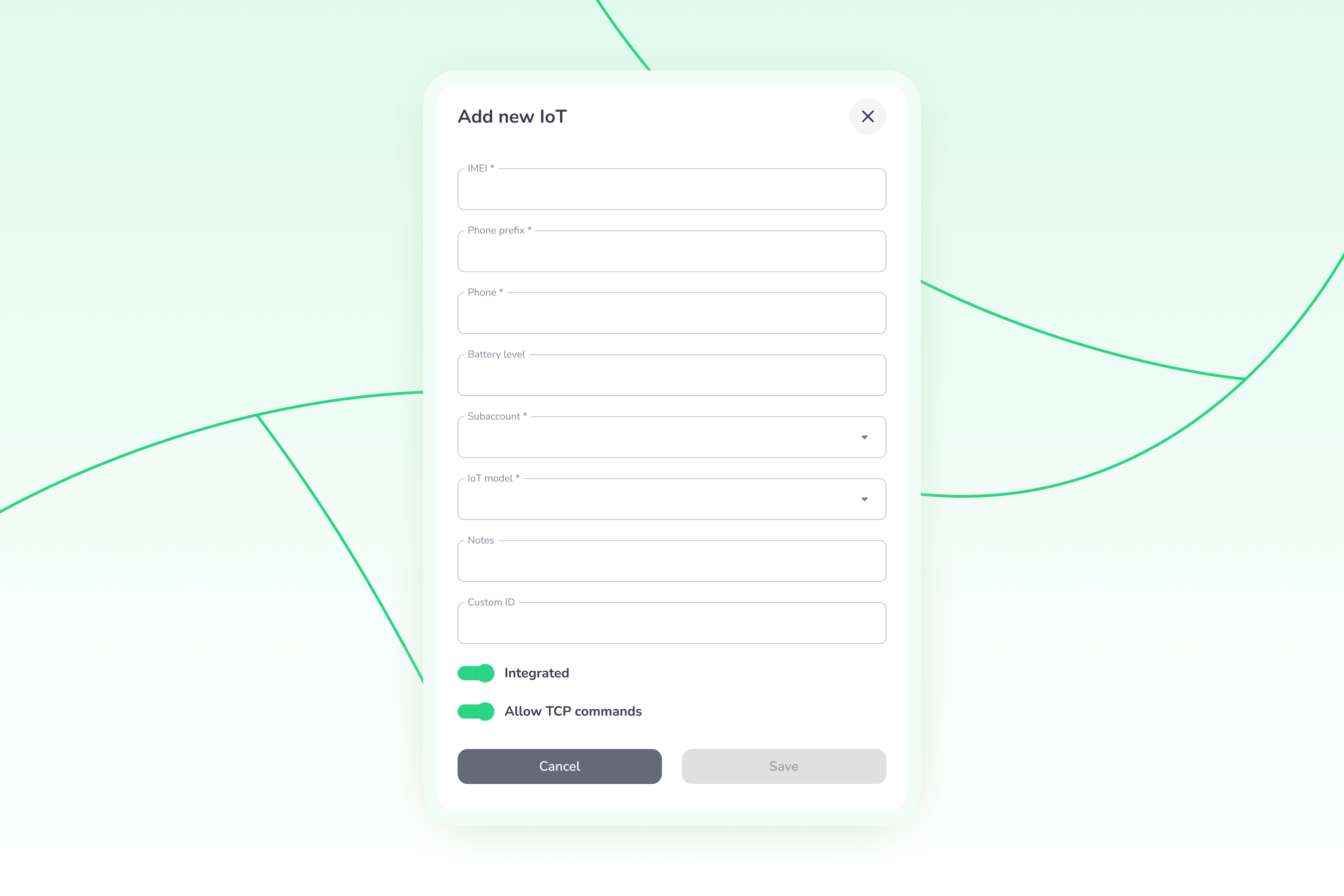
🛴📡 That smooth ride you just took? It was powered by a whole ecosystem of hardware and software you never saw. From IoT modules in the vehicle to real-time dashboards and rider apps, shared mobility relies on a solid tech stack to stay online, secure, and profitable.
You open an app, spot a scooter on the map, and within seconds it unlocks with a click. You ride off, expecting the battery to be charged, the brakes to work, and the whole process to feel effortless. From the very first ride, shared mobility set the standard: vehicles should always be nearby, ready to go, and the whole experience should feel seamless. What most riders never think about, though, is the complex mix of hardware and software working in the background to make every smooth ride possible.
Why the tech matters
Technology is the baseline for the shared mobility business model. Every ride depends on it. Vehicles need IoT hardware to lock, unlock, and report their status. Connectivity has to be stable so operators always know where assets are and what condition they’re in.
On the software side, riders expect apps that feel instant and intuitive, while operators rely on dashboards for fleet health, pricing, and support. Add in the realities of theft, battery swaps, downtime, and local regulations, and the stakes become clear. Without a reliable tech stack, even small failures – a scooter that won’t unlock or a payment that stalls – can quickly break user trust and hurt the business.
Where it began
Over the years, several manufacturers have entered the shared mobility IoT space, offering different hardware configurations, network technologies, and integrations. Companies like Teltonika (Lithuania), Comodule (Estonia), Invers (Germany), OMNI (China) and others produce modules compatible with various vehicle types and connectivity standards. Each provider focuses on specific strengths – some prioritize energy efficiency or compact design, others emphasize global coverage or advanced diagnostics. Choosing between them depends on the type of vehicles, operational scale, and software ecosystem an operator plans to use.
Our partner, Comodule was already developing IoT for micromobility when the Corona pandemic hit. Overnight, cities shifted and everyone needed their own safe, private way to move around. Shared scooters and bikes suddenly went from being a niche service to an essential part of urban transport, and the demand for IoT skyrocketed. For IoT manufacturers, it meant long days in development and manufacturing, pushing hard to deliver reliable devices at scale for brands like Uber, Lime, and Hive.
That sharp rise in demand forced them to grow quickly and gave valuable experience in building technology that could perform under real pressure. Fleets that trusted Comodule devices had a backbone they could rely on: vehicles that could be located, unlocked, secured, and managed internationally. Just as important, the IoT had to integrate seamlessly with software systems (like ATOM Mobility). That’s why building robust API and SDK tools became critical – enabling operators to connect hardware to their platforms, control fleets in real time, and access the information needed to keep moving.

IoT as the brain of the vehicle
Inside every connected scooter or bike sits a IoT module, the “brain” that links the vehicle to the cloud. It connects through cellular networks, constantly sending data about location, speed, and battery status. When a rider taps “unlock” in the app, that command travels through the cloud to the module, which triggers the electronic lock and wakes up the vehicle. The same connection allows operators to set geofenced no-parking zones, push over-the-air updates, or activate a sound alarm if the scooter is being tampered with. Battery sensors inside the module report charging cycles and health, so operators know exactly when a pack needs to be swapped or replaced.
All of this data is streamed in real time to the fleet management system, giving providers the ability to monitor hundreds or even thousands of vehicles simultaneously. For operators, these capabilities mean higher uptime, faster theft recovery, and precise control over the entire fleet – the difference between running a struggling operation and a profitable one.
Rising expectations in the market
As shared mobility matured, the bar kept getting higher. New scooter generations came with swappable batteries, sturdier frames, and better onboard electronics. Riders got used to apps that respond instantly, process payments in seconds, and show vehicle availability with pinpoint accuracy.
At the same time, competition rose, not only from global players but also from smaller, local operators launching fleets in their own cities. For these companies, reliable hardware was no longer enough. They needed the software layer that connects everything: smooth rider apps, powerful operator dashboards, and analytics to make smarter decisions. Yet many lacked the time and resources to build software on their own.

Software as the missing piece
As fleets grew and competition intensified, operators realized they did not have time or funds to develop their own software layer. They needed a market-ready platform that ties everything together – apps that riders enjoy using and dashboards that give operators full control of their business. That’s where solutions like ATOM Mobility come in.
Platform connects directly with Comodule IoT through APIs and SDKs, so every unlock command, error code, or battery update flows instantly between the rider’s app and the operator’s dashboard. Almost any company can launch a fleet with this stack – from large-scale operators to small, local newcomers.
The power of integration
When hardware and software work seamlessly, the rider experience feels effortless. A simple tap in the app sends a command through the cloud to IoT, which unlocks the vehicle and streams live data back in milliseconds. The operator instantly sees the vehicle’s status in the dashboard: battery level, GPS position, and any error codes.
If the scooter leaves a geofenced area, the system reacts automatically. If maintenance is needed, the alert is flagged before it becomes a breakdown. By combining the hardware with software, fleet providers get one complete ecosystem – a stack built to keep vehicles online and users satisfied.
From seamless rides to smarter cities
From a rider’s perspective, shared mobility should always “just work.” That won’t change. But the technology stack behind it is becoming more sophisticated every year. Stricter regulations demand safer and more transparent services, while cities are pushing for integration into broader Mobility-as-a-Service platforms. IoT and software together provide the data and control that operators need, not only to stay compliant but also to improve fleet efficiency and sustainability and to provide insights for city planning.
For users, that sophistication will translate into something simple: services that are more reliable, safer for everyone on the road, and smarter – with data from real-world usage helping to shape better vehicles, better infrastructure, and better cities in the future.
*This article was created together with our partner Comodule.


